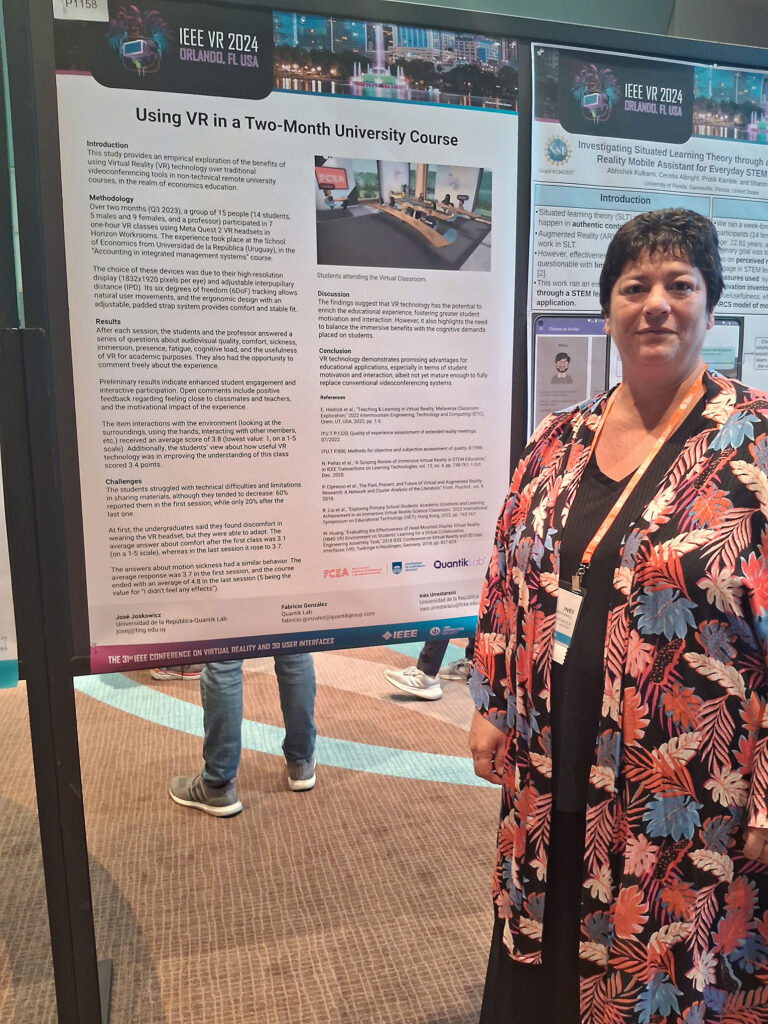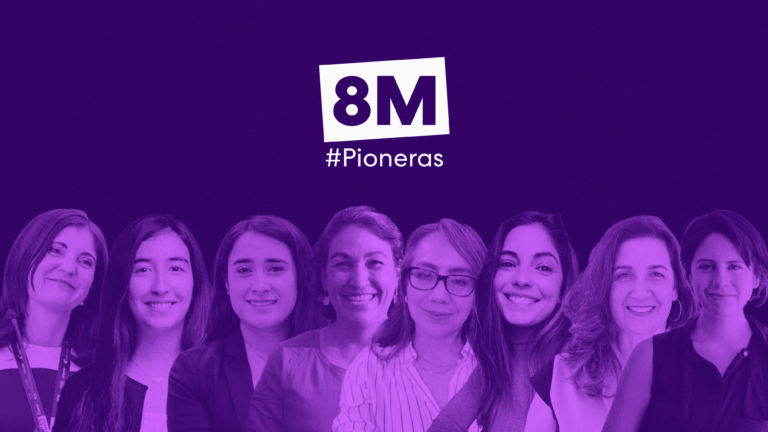At 8 o'clock in the morning, the temperature was already 22 °C (72 °F). Between shirts, skirts and moccasins, from the door of Soriano 1472, the principal was welcoming the students of Colegio Seminario. Francisco Pieri, professor of Mathematics IV of high school, came to meet us and accompanied us to the sixth architecture classroom, which he shares with an artistic teacher.
It is a rather special classroom, with walls decorated with classic and reversioned paintings (such as Velázquez's Las Meninas and Klimt's The Kiss), an "expo sector" (with structures made of plastic bottles and wooden sticks created by the students) and another at the back with benches and high tables for teamwork.
The layout of the tables at the front is not traditional either: arranged in a square U-shape, they leave a space in the middle, which Fabricio González and Martín Píriz ( Quantik Lab's leader and assistant, respectively) took advantage of as a delimiting area for one of the two virtual reality helmets they brought with them.
That's what the visit was all about: for students to have an immersive experience in the metaverse.
What did the activity consist of?
The meeting was conceived thanks to the contact of a teacher from Colegio Seminario with Quantik Lab; the teacher knew that the company was working on metaverse experiences for education. For its part, the educational institution has a focus on innovation, so creating an initiative driven by virtual reality was an interesting activity to present to the students.
The idea was to explore the use of digital tools combined with mathematical skills to generate three-dimensional designs that simulate living spaces. Guided by Pieri, the teens worked in groups for four weeks creating first flat figures and then more complex structures, based on graphs of mathematical functions and curves.
For this process, they used the GeoGebra application (free software that allows them to draw geometric constructions and graph functions), which allowed them to work in 2D. They then used Tinkercad, a 3D modeling program (also free) to create their constructions. The assignment allowed them to choose between museums, bridges, lighthouses, among others.
Once inside the virtual environment, the activity consisted of arranging the objects that made up their designs (which were separate), moving them, scaling them to different dimensions, "getting inside" them and joining them to form the final structure (the museum or lighthouse). At the same time, the two participants could interact with each other: for example, reaching for the elements.
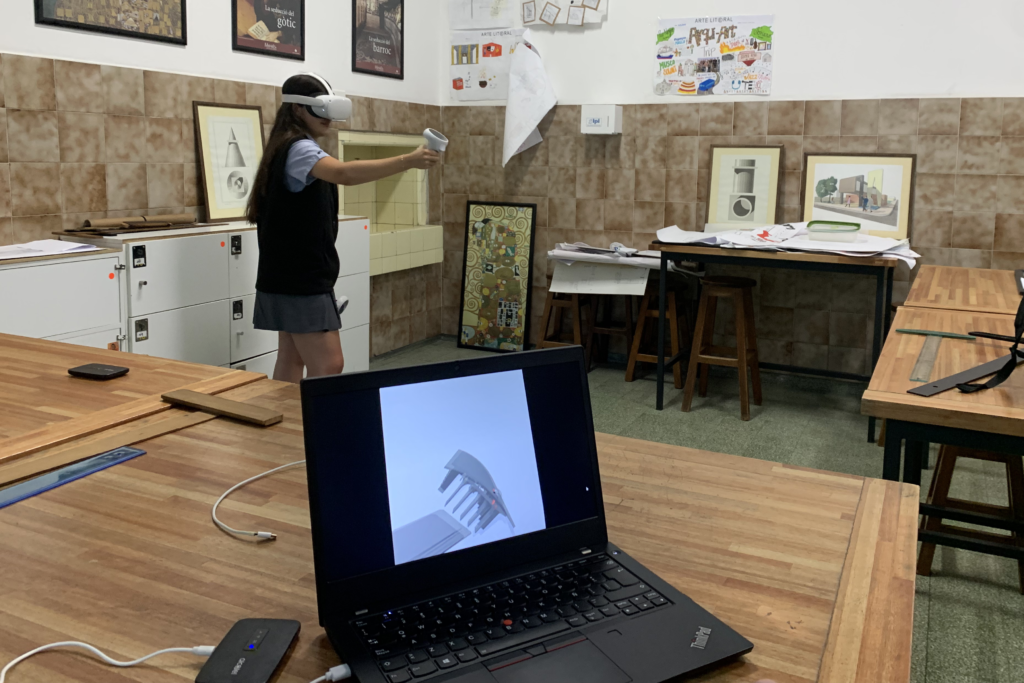
Hands on the controls
With two screens transmitting the same thing that those wearing the two helmets could see, the activity began. Conversations about the graduation party, which would take place in a few days, were interrupted by exclamations of astonishment: "How incredible!
The 17- and 18-year-olds were divided into pairs, according to the teams in which they had worked. Constanza, a future architecture student, said that they had never used an application like this before: "We had tried to use AutoCAD for drawing, but it is much more complex. Francisco introduced us to Tinkercad, and we also linked it with GeoGebra. That was good for putting together different types of functions to help us put together figures, but the experience led us to this [working with the helmet], which is much better".
Ignacio and Juan Manuel designed a lighthouse: "What we did [within virtual reality] was to try to put objects in perspective and interact. For example, I grabbed objects and made it so he could move them in perspective." "We made some stairs that were huge, and if we didn't try them here we didn't realize they were so big," they commented.
Constanza, whose team designed a museum, also commented on the difference between seeing this content on a screen and putting on the glasses: "Seeing what the kids who went before me saw is totally different from what you experience when you put on the helmet. I thought it was going to be much flatter, and in reality you feel that you are literally there; it blew me away".
What difficulties did you encounter when putting on the helmet?
Once the students were immersed in the virtual world, they encountered different obstacles. For example, the duo of Ignacio and Juan Manuel said that at first it was confusing to operate the controls, but "when you get the hang of it, it's quite easy; it's all quite logical, you realize more or less which button is which".
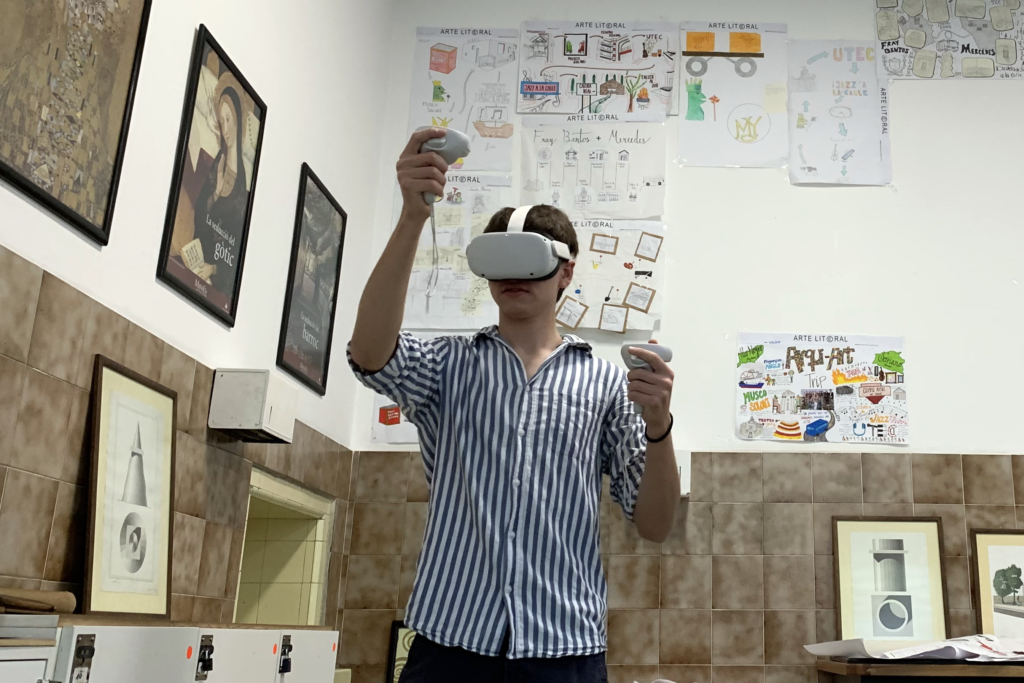
Juan Luca, another of his teammates, found the sensitivity of the environment difficult: "Inside the hull, everything was very sensitive; you get used to it anyway. But at the beginning it's very difficult to control it. It was hard to move around, but it was a lot of fun. Working with a colleague and that we are moving and moving at the same time also makes it fun".
Constanza, on the other hand, referred to a functionality that is not yet developed in the app: "I think the most difficult thing is how to angle things, because there is no rule that shows you 'this is at 90 degrees', so they are crooked".
Of the nearly 12 participants, only one felt a little dizzy, something that coincides with other immersive experiences they have had at Quantik. As Gonzalez said, "From another instance we organized within Quantik, in which more than 50 people participated, we only had one case of dizziness." The manufacturers of the helmets maintain that this is a predictable effect that they are working to eliminate.
A challenge for Quantik Lab
According to González, "what the professor had proposed for this instance was very challenging, because the activity involved mixing a lot of technologies". They had to adapt the idea for the activity: "We took the objects from Tinkercad and had to take them to another application that we found in the virtual reality viewer. In turn, that application had to support two people being able to interact and move the figures."
González referred to the research on virtual reality being carried out at Quantik Lab: "We are exploring real use cases that generate a positive impact on society through products with high potential technologies. This experience is part of the metaverse research, in which we are exploring alternatives for education".
He also pointed out the value of educational institutions being encouraged and open to this type of technology: "These instances are useful to continue advancing with high schools and universities, with a view to creating a specific product to solve problems".
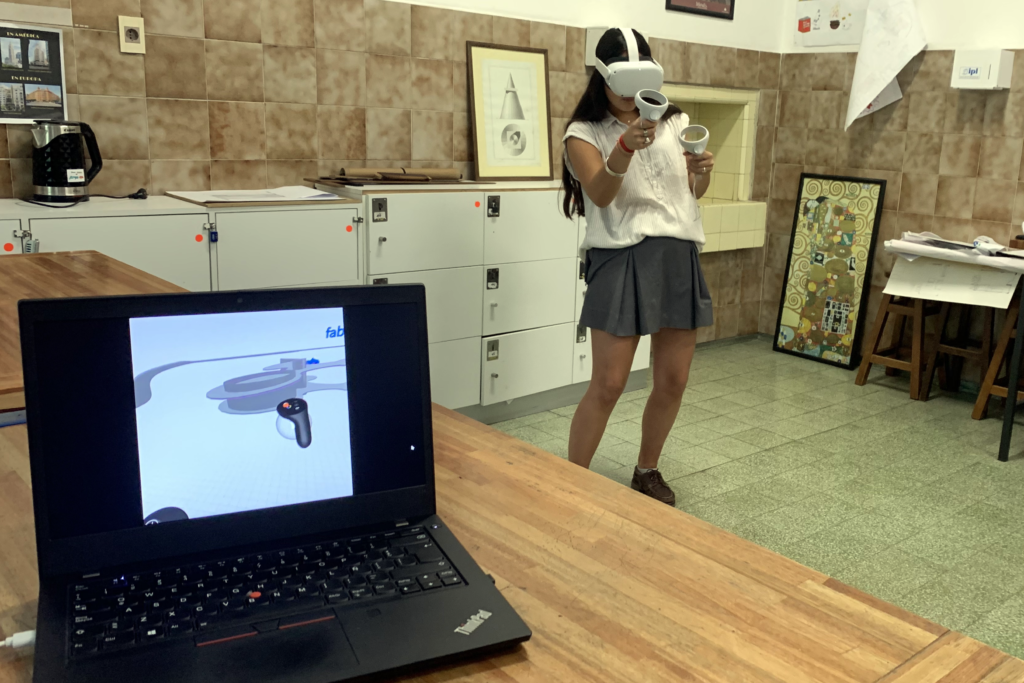
The teaching of the (near) future?
One of the advantages of using these applications in education, whether inside or outside virtual reality, is that young people incorporate knowledge that they can use in other subjects. Federica, one of the students, said that thanks to what they learned in Math IV they used Tinkercad for another subject: "I found it really useful. Now in Drawing we had another project, in which we made a bridge with the same tool".
Juan Luca dared to go a little further: "Some things are difficult to see on the computer, screen or paper, but with this you can see from the inside what things are missing, what is the feeling that a structure transmits to you. All this is very good to save you from having to build it and then see what happens".
Regarding the degree of progress of these initiatives, González commented: "During 2022, we worked with the Colegio Seminario to create two experiences, one with the fifth artistic year, for the subject History of Art (which consisted of touring a cathedral and recognizing elements previously learned in class), and then this one for Mathematics with the sixth architecture year". In 2023, they will work together with more educational institutions at different levels, including university: "Together with their teachers, we will create a different line of learning for each need, with the aim of generating a positive impact on the students".
Undoubtedly, applications like this have great potential for education and professional development. González pointed out: "Familiarizing the new generations with this type of technology gives them more capabilities to develop in the working world, where knowing how to use these tools beforehand is a competitive advantage, as well as anticipating a market need".
About Quantik Lab
Quantik Lab is the area of the Quantik Group dedicated to research and development (R&D). Its objective is to foster and mature the creation of new products and technologies, which can then be scaled. Ideas for exploring new topics come from both customers and partners.
Today, he conducts research on metaverse, internet of things, electric mobility, customer experience and smart cities.
